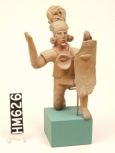Maya
 Ancient Maya civilization spans more than 2000 years (1000BC-AD1542), flourishing in a time during the Classic Period between 300 and 600 AD. The Maya established many small cities that often competed with one another, and ranged geographically from present day Guatemala and Honduras to the northern Yucatan peninsula. An elite aristocratic class made up of Nobles and Priests controlled each city. Both commoners and slaves labored for these elite, and are responsible for creating the architectural monuments the Maya are identified with today. The Maya are known for their incredible advances in mathematics and astronomy, and their success in establishing accurate calendar systems. As an agricultural society, the Maya focused on the production of corn, or maize. In addition, they grew kidney beans, squash, and avocados, and raised a breed of dog to eat. During the 16th century when Spanish explorers such as Cortes began arriving in Latin America, much of ancient Maya civilization had already unraveled due to the internal conflicts that existed between cities. Nevertheless, aspects of the ancient culture continue into the present and can be seen in the Maya descendants still living throughout Latin America.
Ancient Maya civilization spans more than 2000 years (1000BC-AD1542), flourishing in a time during the Classic Period between 300 and 600 AD. The Maya established many small cities that often competed with one another, and ranged geographically from present day Guatemala and Honduras to the northern Yucatan peninsula. An elite aristocratic class made up of Nobles and Priests controlled each city. Both commoners and slaves labored for these elite, and are responsible for creating the architectural monuments the Maya are identified with today. The Maya are known for their incredible advances in mathematics and astronomy, and their success in establishing accurate calendar systems. As an agricultural society, the Maya focused on the production of corn, or maize. In addition, they grew kidney beans, squash, and avocados, and raised a breed of dog to eat. During the 16th century when Spanish explorers such as Cortes began arriving in Latin America, much of ancient Maya civilization had already unraveled due to the internal conflicts that existed between cities. Nevertheless, aspects of the ancient culture continue into the present and can be seen in the Maya descendants still living throughout Latin America.
